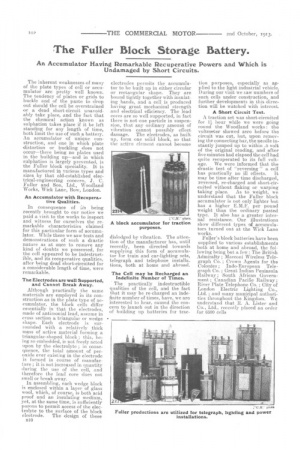The Fuller Block Storage Battery.
Page 6

If you've noticed an error in this article please click here to report it so we can fix it.
An Accumulator Having Remarkable Recuperative Powers and Which is Undamaged by Short Circuits.
The inherent weaknesses of many of the plate types of cell or accumulator are pretty well known. The tendency of plates or grids to buckle and of the paste to drop out should the cell be overstrained or a dead short-circuit unavoidably take place, and the fact that the chemical action known as sulphation takes place if it be left standing for any length of time, both limit the use of such a battery. An accumulator of unique construction, and one in which plate distortion or buckling does not occur—there being no plates used in the building up—and in which sulphation is largely prevented, is the Fuller block speciality. It is manufactured in various types and sizes by that old-established electrical-engineering concern, J. C. Fuller and Son, Ltd., Woodland Works, Wick Lane, Bow, London.
An Accumulator with Recuperative Qualities.
In consequence of s being recently brought to our notice we paid a visit to the works to inspect and witness for ourselves the remarkable characteristics claimed for this particular form of accumulator. While there we saw tests and demonstrations of such a drastic nature as at once to remove any kind of doubts we possessed, for the cell appeared to be indestructible, and its recuperative qualities, after being dead short-circuited for a considerable length of time, were remarkable.
The Electrodes are well Supported, and Cannot Break Away.
Although practically the same materials are employed in its construction as in the plate type of accumulator, the block cells differ essentially in that the electrodes, made of antimonial lead, assume in cross section a triangular or wedge • shape. Each electrode is surrounded with a relatively thick mass of active material forming a triangular-shaped block ; this, being so embedded, is not freely acted upon by the electrolyte ; in consequence, the total amount of peroxide ever existing in the electrode is formed in course of manufacture; it is not increased in quantity during the. use of the cell, and therefore the lead core does not swell or break away.
In assembling, each wedge block is enclosed within a layer of glass wool, which, of course, is both acid proof and an insulating medium, yet, at the same time, is sufficiently porous to. permit access of the electrolyte to the surface of the block
electrode. The design of these electrodes permits the accumulator to be built up in either circular or rectangular shape. They are bound tightly together with insulating bands, and a cell is produced having great mechanical strength and electrical efficiency. The lead cores are so well supported, in fact there is not one particle in suspension, that any ordinary amount of vibration cannot possibly effect damage. The electrodes, as built up, form one solid block, so that the active element cannot become dislodged by vibration. The attention of the manufacturer has, until recently, been directed towards supplying this form of a,ccurriulator for train and car-lighting sets, telegraph and telephone installations, both at home and abroad.
The Cell may be Recharged an Indefinite Number of Times.
The practically indestructible qualities of the cell, and the fact that it may be re-charged an indefinite number of times, have, we are interested to hear, caused the concern to launch out in the direction of building up batteries for trac
tion purposes, especially as applied to the light industrial vehicle. During our visit we saw numbers of such cells under construction, and further developments in this direction will be watched with interest.
A Short Circuit Test.
A traction set was short-circuited for 112 hour while we were going round the Woodland works : the voltmeter showed zero before the circuit was cut, but, upon removing the connecting bar, the needle instantly jumped up to within .5 volt of the original reading, and after five minutes had elapsed the cell had quite recuperated to its full voltage. We were informed that the drastic test of "reversing " a, cell has practically no ill effects. It may be time after time discharged, reversed, re-charged and short-circuited without flaking or warping taking place. As to weight, we understand that the Fuller block accumulator is not only lighter but has a higher E.M.F. per pound weight than the ordinary pasted type. It also has a greater internal resistance. Our illustrations show different types of accumulators turned out at the Wick Lane
works. "
Fuller's block batteries have been supplied to various establishments both at home and abroad, the following being but a few : The British Admiralty ; Marconi Wireless Telegraph Co.; Crown Agents for the Colonies ; Indo-European Telegraph Co. ; Great Indian Peninsula, Railway ; South African Government ; Canadian Pacific Railway ; River Plate Telephone Co. ; City of London Electric Lighting Co., Ltd. ; and many municipal authorities throughout the Kingdom. We understand that R. A. Lister and Co., Ltd., recently placed an order for 6500 cells


























